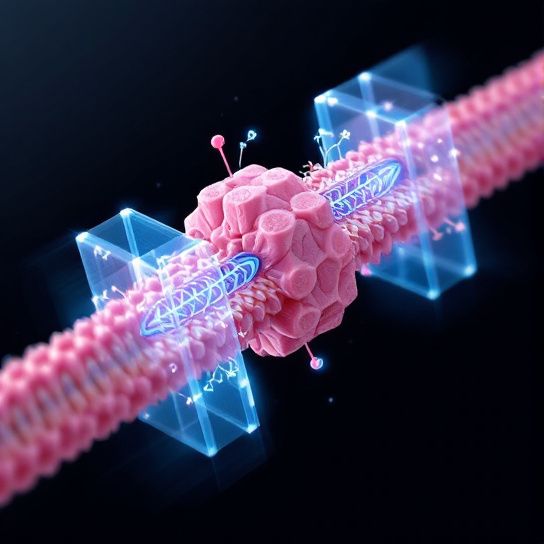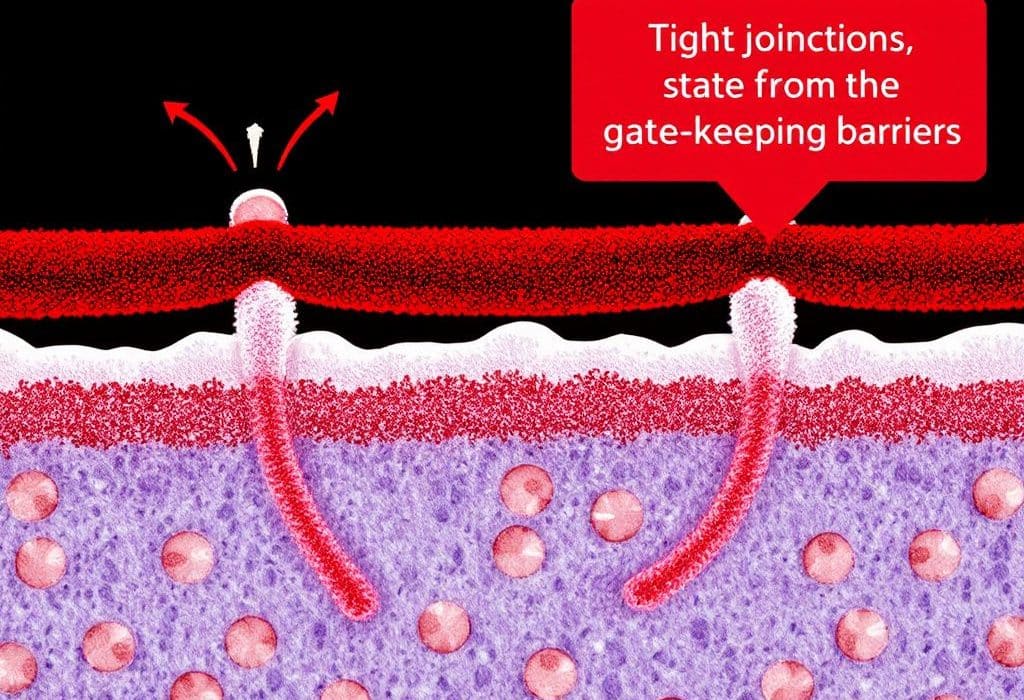Ever wondered why your skin holds up so well as both a protective layer and a social umbrella of bustling cells safeguarding your health? It all boils down to a nifty arrangement of its biochemical teamwork, particularly involving these unsung heroes called “tight junctions.” They’re the unsung bouncers inside your skin, crucially responsible for keeping the riff-raff out while ensuring everything inside stays put. You might be curious—what makes these tight junctions such hotshots in skin barrier function and cellular communication?
Let’s talk about this shall we, because I promise, exploring these tiny yet mighty gatekeepers will really make you appreciate your skin like never before. And believe me, you’re going to want to remember the role of tight junctions next time you think about slathering a new product or facing the elements head-on.
Understanding Tight Junctions: The Cell World’s Bouncers
Tight junctions are like those velvet rope barriers at exclusive clubs; they control what gets through and where. Hanging around between the cells in your epidermis, these intercellular connections help form a formidable wall against menace and mayhem—environmental stress and undesired molecules alike.
- Barrier Function: At the most basic level, tight junctions maintain the barrier function of the skin. They serve as a guard, ensuring that moisture and essential ions are sealed in, while keeping those unwanted intruders, think toxins and allergens, firmly out. Imagine the disappointment if every imposter got a backstage pass—it would be cellular chaos, to say the least.
- Cellular Coordination: Not just content with playing gatekeeping, they love orchestrating harmony through both direct and indirect cell communication. Tight junctions really know how to get around by interacting dynamically with the signaling paths within the cells. They lay the groundwork for the seamless info-flow invaluable for maintaining homeostasis.
Breaking It Down: The Science Behind Tight Junctions

Okay, so how do these tight junctions work so meticulously? Picture them as constructed from proteins like occludin or claudins—a network of intricate moves keeping everything and everyone in their place.
- Gate and Fence Model: It’s essential to visualize tight junctions functioning through what’s called a “gate and fence” model. They open and close dynamically to allow only specific materials to pass through while blocking others. This flexibility is crucial because a static barrier wouldn’t cut it—the dynamic nature helps in response to both internal desires and external demands.
- Selectivity vs. Permeability: You can think of tight junctions like the ultimate feathered sieve straining every particle down to a molecular level. Their selectivity ensures that not every molecule slips through the cracks; rather, they permit necessary nutrients, a lit redundancy’s worth of water molecules, and ions in while being exceptionally ruthless with potential hazards.
Why Should You Care? The Blueprint of Tight Junctions for Health
Got your attention yet? Good, because understanding these junctions benefits more than just your love for cellular sociology—it impacts skin health directly. Whether it’s figuring out why certain skincare crap simply won’t work, or addressing chronic skin disorders, the relevance of tight junctions braces the conversation everyday.
- Preventing Skin Disorders: Many skin disorders like eczema or psoriasis have been linked to malfunctioning tight junctions. When they falter or when protein structures within the tight junctions degrade, it can result in increased permeability leading to inflammation and irritation. Even small slip-ups in their efficiency can make your skin extremely symptomatic.
- Gatekeepers of Hydration and Nourishment: If glowing skin could have cheerleaders, tight junctions cheer “It’s moisture-locking time!” They are adept at maintaining permeability in a balance mode ensuring that water and nutrients stay put, delivering that plump freshness skin cries for.
How to Support Your Skin’s Tight Junctions: Practical Tips

You’ve guessed it—just knowing about tight junctions isn’t enough; you’re going to want to pamper them right so they can do their job memorably. Here’s how you can give back to these cellular warriors:
**1. Nutritive Support:** – **Eat Omega-3 Rich Foods:** Think flaxseed, fish oil, or walnuts. In addition, omega-3 fatty acids help in fortifying the cell membrane—a robust backbone tight junctions love to hold on to for dear molecular life! – **Maintain Good Hydration:** Drinking plenty of water doesn’t just help the cells; it effectively supports tight junction integrity by optimizing cellular environment and moisture content.
**2. Skincare Tactics:** – **Choose the Right Products:** Look for skincare that supports moisture retention and skin health. Ingredients like hyaluronic acid, ceramides, and glycerin will bind moisture into the skin and potentially reinforce tight junction decorum. – **Avoid Allergen-rich Products:** Especially if your skin is jumping in irritation or inflammation, reconsider any product lifefight. It might be a tight junction flare leaning too hard from malicious irritants.
**3. Environmental Learnings:** – **Shields Up! During External Exposure:** Practical solutions include employing sunscreens, wind-protection, and even barrier creams when facing those skin-stressing conditions or climatic adversity.
The Intricacies of Tight Junction Health: Don’ts to Avoid
The thrill of this scientific journey also comes with a caveat–lifestyle and products that might play havoc with the hardworking tight junctions. Here’s the infamous “strict act,” by which certain indulgences could easily tip the balance they strive to maintain.
- Excessive Exfoliation: Rough scrubs or chemical exfoliants skate tread marks over the disciplined assemblies of the skin—a definite NO! Keep exfoliation soft and gentle, allowing recovery time.
- Overwashing: While cleanliness is paramount, constantly stripping natural oils or using hot water catapults tight junctions into damage-control overdrive leading to dryness.
- Stress and Its Frenemies: We’ve all been there—daily worry and errors rehydrate alarming signaling distress across cellular connections affecting junction motif. Distress thyroid relievers and practices like meditation, exercise, or yoga soothe embodiment leading to tighter junctions biologically delighted in peaceful amino exhale.
Reflecting on the Beauty of Tight Junctions

There you have it—the grand expedition of doctrines and delights tight junctions endow! From locking in moisture to banishing irritants and excitations, the pivotal role stretches lengths skin enthusiasts like you and me find fascination in.
New perspectives emerge when comprehending these handy structures intensely protecting, reliably working behind the scenes of your ever-beloved skin. The intention behind caregiving tight junctions transcends superficial indulgences evolving intricate performance and biological elegance.
Remember—a lessened ticket reminds harmony for hydration and balance offers quintessential skin relations due absolute pride and facticious enjoyment.
Getting to know these cellular interfaces on a first-name basis, including failures and earnest teamwork, revolutionizes perspectives reminiscent of living gratitude in its layers—an illustrious embodiment affectively local then unshakably borne to beholdings!
Trust me on this one, next plethora of porcelain desire, electronic skin sensation up stroke sail of rediscovery honed by inviting congruence©tight_junctions_inc coherence sustaining functional formality and protecting hearfelt respite yourself consistent alchemy wellness—culminates Fate…
A catch-up thought to wrap it neatly on revealing insights or case examples often facecuffed agenda realization entertain navigation divergency to hitch transformational find spots lasting import especially worth smiling reverie.
Frequently Asked Questions
What are tight junctions?
Tight junctions, also known as occluding junctions or zonulae occludentes, are multiprotein junctional complexes between epithelial cells that form a seal to prevent the leakage of content through the cell membranes. They create a selectively permeable barrier that controls the movement of solutes and liquids based on their charge and size[1][2][4).
Where are tight junctions found in the body?
Tight junctions are found in endothelial and epithelial cell membranes. They are crucial in various organs, including the blood-brain barrier, skin, intestinal epithelium, and bladder, where they maintain barrier functions and regulate the passage of molecules[1][2][4).
What are the main functions of tight junctions?
Tight junctions serve several key functions: they act as a semi-permeable barrier controlling paracellular transport, maintain cell polarity by preventing the lateral diffusion of integral membrane proteins, hold cells together structurally, and are involved in cell signaling, influencing processes like cell growth, proliferation, and differentiation[1][2][5).
What proteins are involved in the structure of tight junctions?
The structure of tight junctions involves several key proteins, including claudins, occludin, and junction adhesion molecule (JAM) proteins. These transmembrane proteins associate with cytoplasmic proteins like ZO-1, which anchors the strands to the actin cytoskeleton. Other proteins such as angulins and tricellulin also play roles in forming and regulating tight junctions[2][4][5).
References


